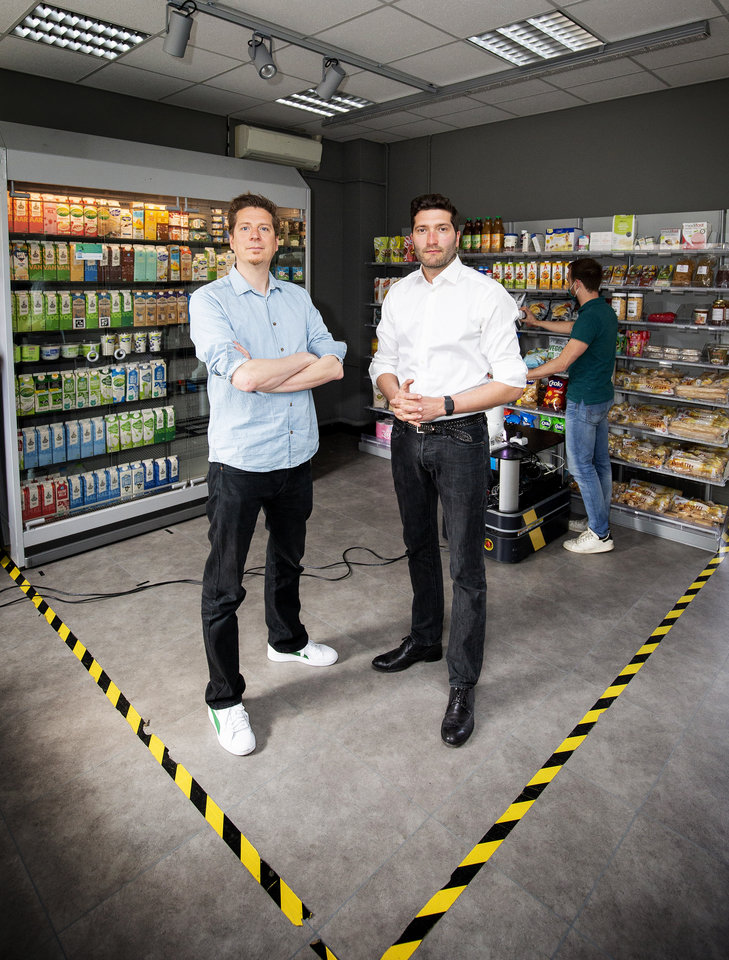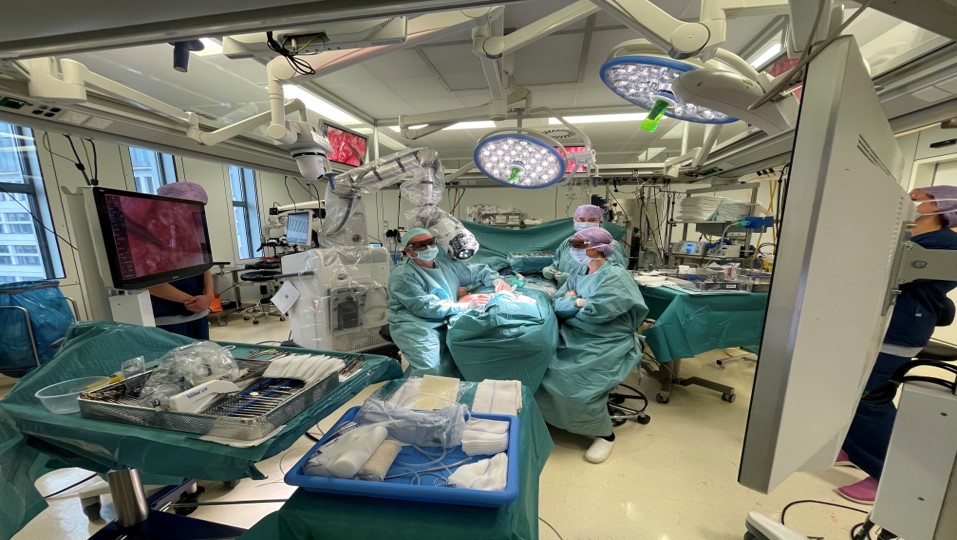Technology made by and for professionals
For years, robotics developers have sought to create instruments to support the healthcare industry but the results have been underwhelming. Working with nurses at Erasmus MC, Professor of Haptic Human-Robot Interaction David Abbink demonstrated that it is possible to turn things around. ‘I had no idea what they were doing.’
By Rianne Lindhout • December 11, 2023
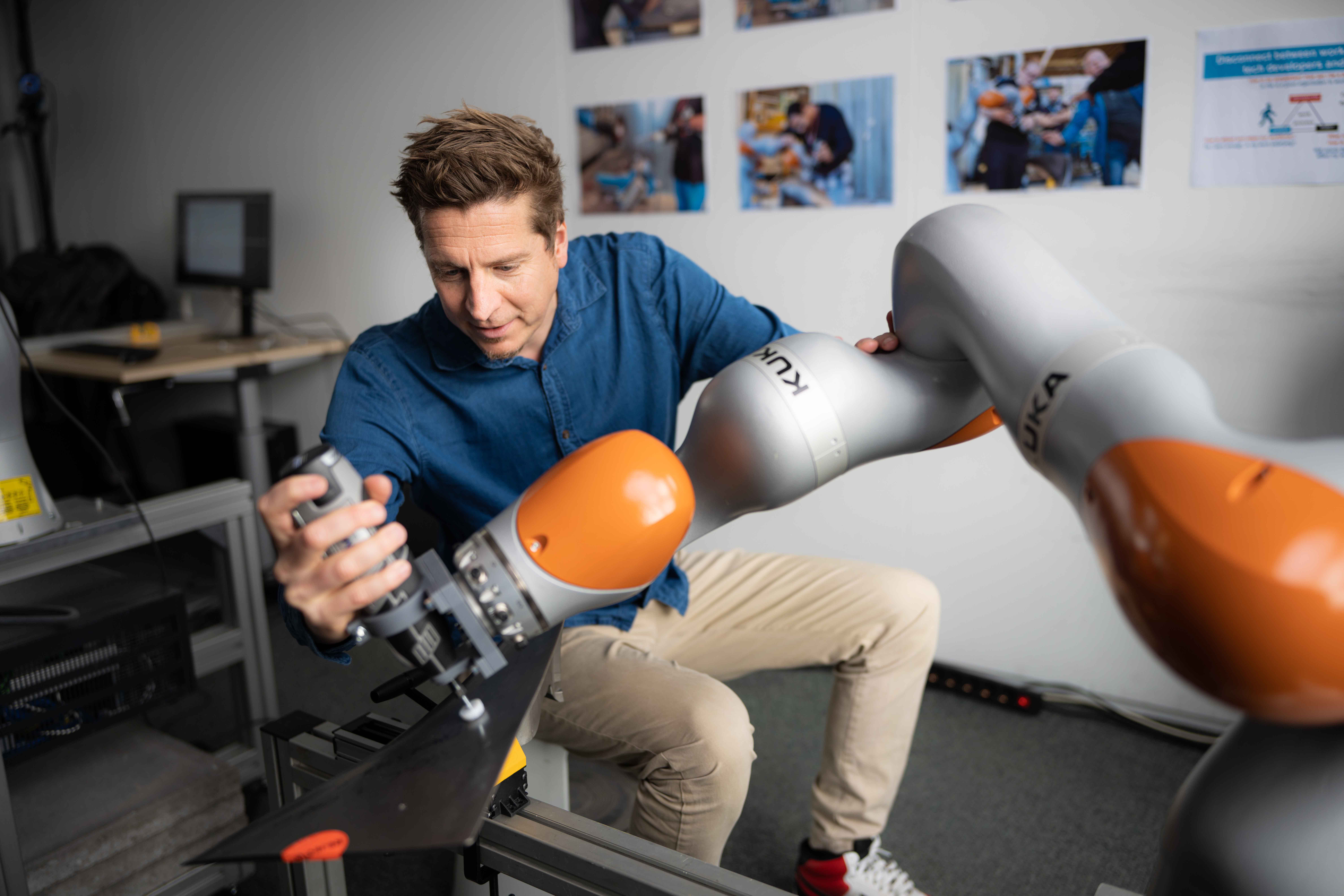
David Abbink, Professor of Haptic Human-Robot Interaction at TU Delft © Guus Schoonewille
You might have seen them before: cute little hip-height, big-eyed robots that buzz around and talk to patients. They can help children manage their diabetes or keep elderly patients company. Given the dire staff shortage in healthcare, they sound like an ideal solution.
While they’re certainly adorable, the actual assistance they provide is disappointing, argues TU Delft Professor of Haptic Human-Robot Interaction David Abbink. ‘These Pepper robots, as they’re known, might look amusing but most of them are collecting dust in hospitals or the classrooms in which they were supposed to help pupils learn arithmetic. The demo videos cast them as gregarious creations that you can have a nice chat with, but they’re rather difficult to interact with in practice. When push comes to shove, they’re little more than an iPad on wheels.’
Sitting idle
The medical sector abounds in tech support and advanced tools but they’re still pretty much invisible in the workplace. Professor of Nursing Science Monique van Dijk of Erasmus MC explains that even minor details can interfere with adoption. ‘Erasmus MC introduced smart beds that could also weigh patients, which would make weighing bedridden patients considerably easier. But no one ever explained how the beds worked and nurses didn’t trust the readings, which meant that, before long, the smart new devices were sitting idle. The same can happen if workers don’t know how to report malfunctioning equipment.’
Abbink expects that self-learning future technologies, such as robotic assistance, will be even harder to implement. That’s why he is committed to improving alignment with real workplace needs and wishes, ‘so that professionals will enjoy providing care in the long run. Only then will technology actually help combat labour shortages.’ Abbink helms the FRAIM research centre, where researchers can freely experiment with technology and test its impact in controlled environments. Its current focus areas are mechanical and repair work, healthcare, and baggage handling at Schiphol Airport.

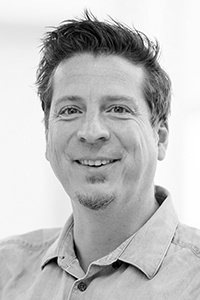

Academics need non-academic knowledge to make a difference
Whether they’re looking to improve the health of an entire neighbourhood or exploring ways to help farmers green their operations, more and more researchers seeking to bring about societal change are discovering the same critical success factor: transdisciplinary collaboration.
At the turn of the century, interdisciplinary research emerged as a new trend. For example, we learned that unhealthy behaviour is often sparked by multiple factors, such as poverty or other stressors. Healthy lifestyle advice alone is not the solution, so you need to go beyond a purely medical approach. While an interdisciplinary team with behavioural scientists and sociologists will be slightly more effective, more is needed to actually improve public health. To be truly effective, the team will have to join forces with all stakeholders that can play a part in the solution, such as community centres, GPs, urban planners, other policymakers and, last but not least, the actual people involved. True transdisciplinary science is the best way to prevent blind spots.
Blind spots
Technology development is only a small piece of the puzzle Abbink wants to solve to develop truly relevant workplace innovations. ‘The best solutions are social, organisational or logistical, not technological. I can tell you a lot about fostering cooperation between robots and people, and a psychologist knows exactly how to research and encourage well-being in the workplace. The problem is that everyone has blind spots. In other words, you need a diverse group of academics, professionals and relevant experts to engage in collective blind-spot reduction to develop an effective robot or technology.’
Abbink was given six months to test his ideas in a pilot project at Erasmus MC, seeking first and foremost to address the systemic shortage of nursing staff. There is no cut-and-dried solution but many have turned to the field of robotics for help. Instead of quickly rolling out a prototype, Abbink decided to put together a broad team of young researchers, including a nursing scientist, an organisational scientist, a designer, a robotic expert, a social scientist and an innovation expert. The team did their required reading, conducted workplace visits and found a team of nurses to work with, before shadowing two oncology nurses to get an accurate picture of their day-to-day activities.
An eye-opener
All the time spent observing and searching for things was surprising to say the least, says Abbink: ‘We learned that we didn’t have a clue as to what nurses do all day, how complex their job is and how many tasks they have to navigate! No matter what happens, they always get everything done. It’s a very commendable effort.’ It even caught senior oncology nurse Janno Wouters by surprise. ‘I knew that we’re incredibly hardworking, creative and capable problem-solvers, and my pedometer tells me that I cover considerable distances every day. Still, seeing the routes on paper was an eye-opener. I would never have imagined that I walked that many rounds through wards and past patients.’
In a workshop also attended by nursing team leaders, the group identified their needs and wishes and scoped out possible solutions for the future. Professor of Nursing Science Van Dijk: ‘Making a bed isn’t much fun but having a chat with the patient at the same time can be. It’s important that you carefully consider whether technology has added value.’ She is hopeful that technology can help in some other way: ‘Nurses spend an awful lot of time looking for stuff. There’s nothing more annoying than discovering that the last wound dressing has just been used. The solution? A brisk walk to the Plastic Surgery ward.’
‘Using the arm helped me see its added value in the provision and preparation of medication’

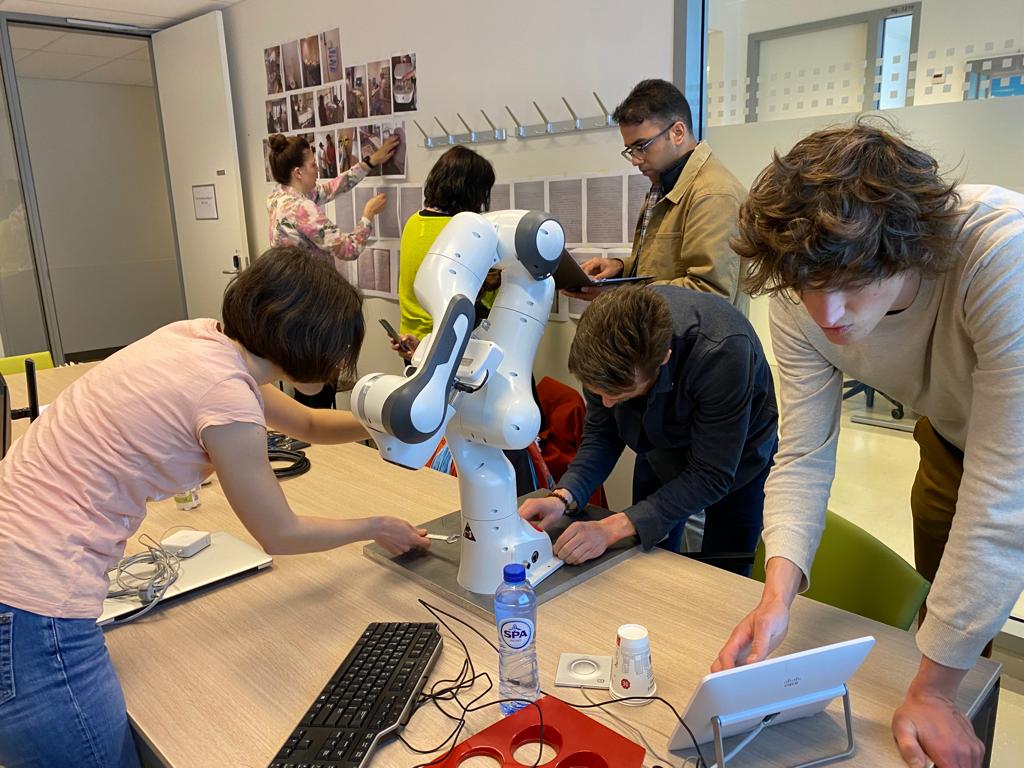

Oncology nurses discover the capabilities of a robotic arm during a workshop. Through this physical experience, more concrete ideas emerged for plausible robotic support for their work: for example, taking the blood sampling supplies or medication from (or handing them over to) the nurse. © David Abbink
FRAIM is working on the future of work
In view of the ageing population, fewer workers will have to produce more and take care of more pensioners in the future. Robotisation may be part of the solution. Research centre FRAIM explores how humans and robots can work together symbiotically in the workplace. Efficient and meaningful work is the end goal, prompting the researchers to combine technical and social sciences and tap into the non-academic knowledge of the employees and organisations involved. Abbink: ‘A key part of the FRAIM method is that people throughout the organisation take the time to listen to each other, triggered by a reflection on the findings reported by the researchers.’ KLM Engine Repair and Schiphol's baggage handling department already use FRAIM's expertise. There are also clear-cut opportunities in the construction and cleaning sectors, and robots can also help lay the cables needed for the energy transition.
Why am I just hearing about this now?
For some team leaders and managers, the workshop was the first time that they heard what their people were up against. ‘Why am I just hearing about this now?’ was a commonly heard response. Usually, nurses simply find a solution and don’t have time to consider the alternatives, so they push through and don’t complain. Wouters: ‘I was amazed at what happened when I was encouraged to let go of my reticence and allow my imagination run wild. In the past, I tended to stress the restraints and problems and wonder whether something was even possible.’ Wouters’ colleague Ada Langendoen got to test a robotic arm during the workshop and saw its merits: ‘Actually using the arm helped me see its added value in the provision and preparation of medication.’
Good for the relationship
The final session of the working group revolved around reflection. Abbink: ‘Nurses are worried that the advent of robots would lead to them having to treat even more patients in less time, while they mainly want to spend more time with patients. Team leaders, on the other hand, argued that labour shortages might force them to make unpopular decisions.’ The honest exchange of thoughts and ideas helped create mutual understanding. People realised that they’re all facing the same issues, which improved the relationship between them.
So did the participants come up with an idea for a device that will actually be adopted? A smart medical supply room that orders dressings automatically when stocks run low, perhaps? We’re not quite there yet, Abbink admits. ‘This was only a prelude, the first step towards finding ways to address complex workplace issues. It was an unmitigated success. We managed to identify ways to prioritise real-life impact in research and innovation by working with representatives from every layer of the organisation.’
